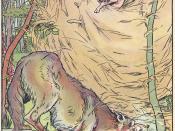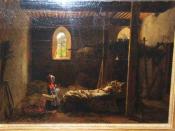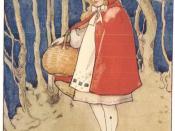The three hairy pigs There are many folktales in the world. Many of them have variants or differences that make each story sound the same but in the end affect the meaning. Cinderella, Little Red Riding Hood, and The Three Little Pigs all have variants in their stories. With the Three Little Pigs comes a variant entitled The Three Hairs. One can see the differences in these two stories as they are compared, while each may seem the same, in the end the meanings of the stories end up being variants also.
The Three Little Pigs by S.D. Schindler tells the story of two pig boys Rooter and Oinky, and one girl pig, the smallest of the three, Hamlet. Also in this story there is a mother. She thinks that her sons are getting fat so she sends them out to make their own house telling each three rules before they leave, her daughter leaves on her own will.
The first rule is to "watch out for the tricky, old, drooly-mouthed, fox"ÃÂ. Second, she asked them to make their house out of rocks. Finally, the mamma pig told her sons to visit her every Sunday. Both stories have a fox instead of the traditional wolf. The fox in the Three Little Pigs only captures the first two sons, and the daughter goes to rescue them, which is why she left her mother. The daughter is the only one who makes the house out of rocks, the others were two tired or homesick to even start to make a home and they just sat and ate the food their mother gave them. While they stopped, the fox captured them and locked them in his lair. This variant of the little girl rescuing her brothers makes sense because women have always been deemed the underdogs and in this 1989 version the author gives a more politically correct stance on a long time traditional story.
The characters are different in the folktale The Three Hairs. Not only are the main characters rabbits, but they are all boys. There is also a father and a mother. The father in this story is the one who gives the advice. He tells each of his sons that they are getting too big and must leave the hole. The father advises his sons on two topics: one, two go and dig their own holes, and two, to stay near home. As in most traditional "little pig"ÃÂ stories, the first two sons do not listen to their father but build their house in other ways. The first hair built his house out of "leaves, moss, sticks, brushwood, and whatever else he could find"ÃÂ. The little hair got hungry and left his house. The fox met him and chased him home. A variant between this and the other story is that instead of the fox just capturing the animal, in this one he tore down his house made out of sticks and ate him up. The same happened to the second rabbit, although he made his house under the roots of a tree. These houses are variants also. In the first story the pigs did not even get a chance to build their house, except for the daughter who listened to her mother. The last rabbit in The Three Hairs, like the daughter in the first story, listened to his father and dug his hole. The fox could not get him.
As these characters in both stories fought with the evil fox, only in one did someone do something about him. In The Three Little Pigs the little girl was the last to run into the "mean, tricky old, drooly-mouthed, fox"ÃÂ. She was wily enough to capture the fox in a bag, smashed his nose in her door, and made him climb in a butter churn then while inside pushed him in a river, never seeing him again and saving her brothers. However, in The Three Hairs the wily rabbit just runs away to his hole and the fox just eventually runs away. This variant is either the author giving his own flourishes, that of which he said he did in the index of the book, or how the different cultures described each story.
The Three Little Pigs story ends with a fine and dandy ending. All the pigs are pictured eating Sunday dinner with their mother and there is not a scratch on them. They eat and are happy just like they were before. Justice has been done, the fox is gone and life goes on. But in The Three Hairs there is a stagnant ending. The fox gets away, but never to return. The last rabbit does not even show remorse for the loss of his brothers. The reader never even finds out if the parents know that their children are dead.
Each story, one about pigs in rock houses, and another about rabbits in holes, tell the moral of listing to one's elders. The elder in The Three Little Pigs is the mother, while the meaning changes as the elder does in The Three Hairs by the father. Because the fox gets punished the moral of the pig story is if you are evil you will be punished, but in the rabbit story the fox gets away, so the meaning must stay as listen to your elders, for they are wise.




